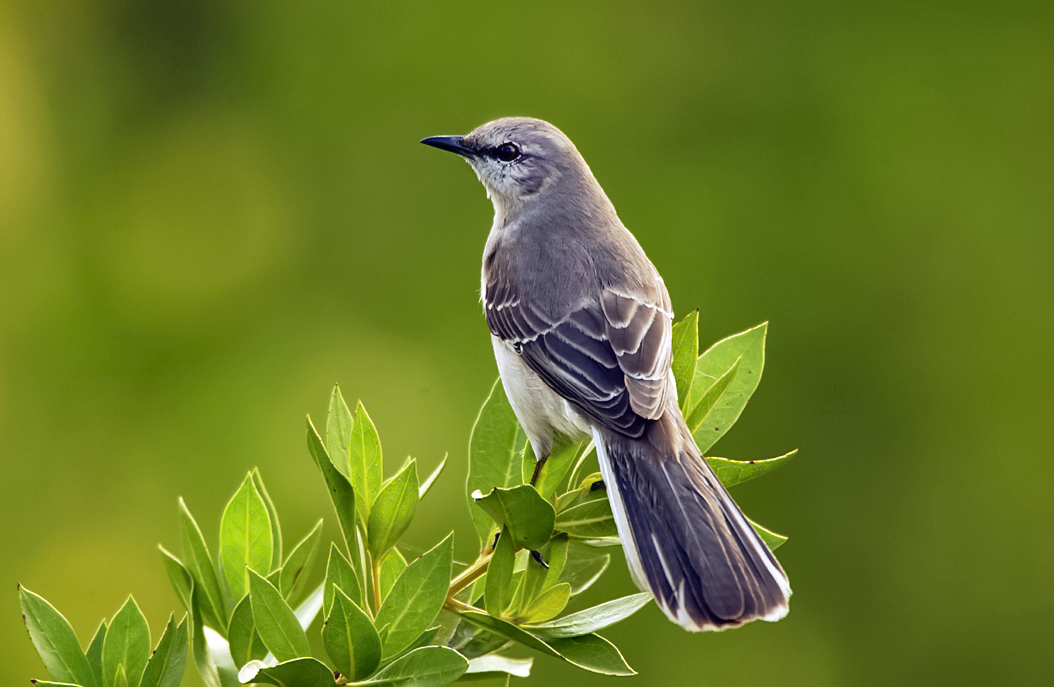
Summer is the perfect season to photograph colorful birds.
Northern Mockingbirds
northern mockingbird © Ken Thomas
These accomplished mimics are year-round residents in Massachusetts. Their loud, complex song creations can be heard in many a neighborhood and garden in spring and summer, but come winter mockingbirds adopt a lower profile. Sheltering in thick tangles and foraging for berries and other soft fruits, northern mockingbirds are quieter but still present throughout the colder months.
Identification
Mockingbirds have slender bodies, long tails, and short, straight bills. Bill to tail tip, an average individual measures 10”.
Northern mockingbirds are mostly an unremarkable gray, with pale breasts and stomachs and dark wings. When a mockingbird flies, it reveals bright white patterns on the wings and tail that serve as excellent field marks.
A northern mockingbird’s “song,” often delivered from a branch tip, rooftop, fencepost, or other conspicuous perch, is composed of phrases mimicked from other birds, each repeated several times in quick succession. Other noises, like car alarms and cell phone rings, are also mimicked occasionally. A mockingbird with a large and diverse repertoire stands a better chance of impressing a mate.
Behavior
During the breeding season, northern mockingbirds are easy to see, whether singing from a prominent perch or pugnaciously chasing off rivals and competitors. Mockingbirds hunting insects will run along the ground, occasionally pausing and half-raising their boldly patterned wings in an effort to startle insects into flight.
In the winter, mockingbirds often perch in evergreen shrubs or thick tangles that afford some protection from harsh weather, and their diet shifts to being dominated by berries and fruit.
Night Singing
Mockingbirds are in the family, Mimidae, which means mimic or imitator. The mockingbird has been known to make the vocalizations of almost 40 birds, as well as a creaking door, barking dog and whistling mail carrier.
One of reasons people notice mockingbirds is because they are frequently heard singing in urban and suburban neighborhoods at night. The male virtuoso sings his repertoire anytime to attract a female. This behavior occurs during breeding season in late spring and early summer and usually lasts only two or three weeks at the most. Mockingbirds have two broods each season so the singing may start again in mid-summer for another brief period.
Other birds that can be vocal at night during breeding season include several common species of owls such as barred, great horned, screech, and saw-whet. Great horned owls can start night calling as early as February.
If the night singing is disrupting your sleep, you can use any type of white noise to drown out the sound of the mockingbird or purchase a pair of soft ear plugs.
northern mockingbird © Ken Thomas
These accomplished mimics are year-round residents in Massachusetts. Their loud, complex song creations can be heard in many a neighborhood and garden in spring and summer, but come winter mockingbirds adopt a lower profile. Sheltering in thick tangles and foraging for berries and other soft fruits, northern mockingbirds are quieter but still present throughout the colder months.
Identification
Mockingbirds have slender bodies, long tails, and short, straight bills. Bill to tail tip, an average individual measures 10”.
Northern mockingbirds are mostly an unremarkable gray, with pale breasts and stomachs and dark wings. When a mockingbird flies, it reveals bright white patterns on the wings and tail that serve as excellent field marks.
A northern mockingbird’s “song,” often delivered from a branch tip, rooftop, fencepost, or other conspicuous perch, is composed of phrases mimicked from other birds, each repeated several times in quick succession. Other noises, like car alarms and cell phone rings, are also mimicked occasionally. A mockingbird with a large and diverse repertoire stands a better chance of impressing a mate.
Behavior
During the breeding season, northern mockingbirds are easy to see, whether singing from a prominent perch or pugnaciously chasing off rivals and competitors. Mockingbirds hunting insects will run along the ground, occasionally pausing and half-raising their boldly patterned wings in an effort to startle insects into flight.
In the winter, mockingbirds often perch in evergreen shrubs or thick tangles that afford some protection from harsh weather, and their diet shifts to being dominated by berries and fruit.
Night Singing
Mockingbirds are in the family, Mimidae, which means mimic or imitator. The mockingbird has been known to make the vocalizations of almost 40 birds, as well as a creaking door, barking dog and whistling mail carrier.
One of reasons people notice mockingbirds is because they are frequently heard singing in urban and suburban neighborhoods at night. The male virtuoso sings his repertoire anytime to attract a female. This behavior occurs during breeding season in late spring and early summer and usually lasts only two or three weeks at the most. Mockingbirds have two broods each season so the singing may start again in mid-summer for another brief period.
Other birds that can be vocal at night during breeding season include several common species of owls such as barred, great horned, screech, and saw-whet. Great horned owls can start night calling as early as February.
If the night singing is disrupting your sleep, you can use any type of white noise to drown out the sound of the mockingbird or purchase a pair of soft ear plugs.
Advertisements
05 June 2022
Advertisements



